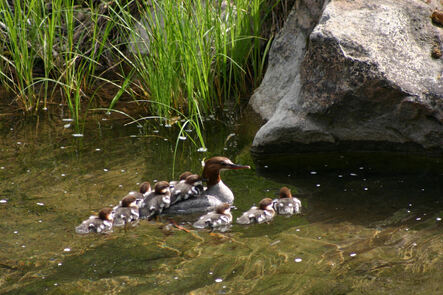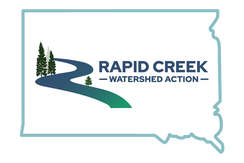What is a Recreation Area – And What Does It Mean?
For over 40 years I have lived along Rapid Creek and regularly enjoyed Summers swimming and fishing in the Creek, and fishing, swimming and kayaking in Pactola Lake. In the winter months, the creek provides a frozen pathway for hiking upstream through miles of wilderness in Dark Canyon.” - Bruce Ellison
There are two basic types of recreation areas on land that is controlled by the federal government, including land controlled by the Forest Service. Some recreation areas are designated by the U. S. Congress, as we are working to do for the Rapid Creek watershed, and are permanent (unless the law is revoked). An example of this is the Sheridan Lake recreation area in the central Black Hills (Sheridan Lake is not in the Rapid Creek watershed). This recreation area includes grazing, in addition to recreation opportunities and a business.
The second type of federal recreation area is administrative, rather than done by Congress. It is created by the federal agency that controls the land, and it lasts for 20 years. In most of the central Black Hills, this controlling federal agency is the U.S. Forest Service. The Pactola Reservoir area is an example of an administrative recreation area.
We are NOT proposing that the area be designated as a “National” Recreation Area, which could negatively impact agriculture and limit recreation opportunities. We want to protect and maintain the current activities in the watershed. We are looking for a Congressionally-designated recreation area like the one that includes Sheridan Lake.
Under our proposal, water rights would not be impacted. Grazing allotments would not be impacted. Tribal lands would not be impacted. Property holders would not be impacted except to the extent that they would no longer need to worry about a mining company coming along and uprooting their operation. This is currently permitted under an 1872 federal law and has happened across the West, including in the Black Hills.
The second type of federal recreation area is administrative, rather than done by Congress. It is created by the federal agency that controls the land, and it lasts for 20 years. In most of the central Black Hills, this controlling federal agency is the U.S. Forest Service. The Pactola Reservoir area is an example of an administrative recreation area.
We are NOT proposing that the area be designated as a “National” Recreation Area, which could negatively impact agriculture and limit recreation opportunities. We want to protect and maintain the current activities in the watershed. We are looking for a Congressionally-designated recreation area like the one that includes Sheridan Lake.
Under our proposal, water rights would not be impacted. Grazing allotments would not be impacted. Tribal lands would not be impacted. Property holders would not be impacted except to the extent that they would no longer need to worry about a mining company coming along and uprooting their operation. This is currently permitted under an 1872 federal law and has happened across the West, including in the Black Hills.
Pactola and Mining ClaimsMineral claims for hard rock minerals – such as gold, silver, and uranium -- on federally-controlled lands can be made under the 1872 General Mining Law. These claims overcome the rights of surface landowners, and mining companies can kick surface owners or residents off the land and out of their homes. For example, residents of the town of Trojan were evicted by the Wharf mine in the northern Black Hills. And, of course, mining changes the uses of the land, often permanently, as at the Homestake open cut in Lead.
If the miners prove that there is a valuable mineral on the land they have claimed, they can get a patent, which means ownership of the surface and subsurface rights. Under the 1872 law, miners do not have to pay any royalties to the federal government. Currently, much of the land around Pactola Reservoir, including the northern shore area, is under claims by F3 Gold (see map). While the Black Hills National Forest's Management Plan says that the area should be protected from new mineral development, the claims circle the lake and cover much of the surrounding area. So under the 1872 Mining Law, if F3 Gold finds a mineral deposit, they can take control of anywhere in their claims area where they find minerals. As of May 2020, their claims around Pactola Reservoir were still active, and the Forest Service had shown no sign of enforcing the “No New Mineral Development” plan. Meanwhile, F3 Gold has applied do exploration drilling in the Jenny Gulch area, just upstream from Pactola. This would be disastrous for outdoor recreation and for Rapid City’s water supply, which is held in the Reservoir. Creating the Rapid Creek designated recreation area would prevent this from happening. In the Black Hills region, the federal Bureau of Land Management (BLM) controls underground mineral rights. This includes mineral rights under Forest Service lands and under lands that are owned by private individuals who did not purchase their mineral rights.
Under treaty law, the Black Hills belong to the Lakota under the 1851 and 1868 Fort Laramie Treaties. This issue has been to the U.S. Supreme Court several times, and in 1980, the Court ruled that the lands had been illegally taken from the tribe. However, to date, the federal government has not returned any lands to the Lakota. Disclaimer: this statement has no bearing on this proposed RCWA legislation nor does it impact any treaty rights or Government to Government relationship with the tribes regarding federal governmental policies and procedures mandated by law. In addition, the federal Bureau of Reclamation manages Pactola Reservoir’s Dam, Deerfield Reservoir’s Dam, and the water in the reservoirs. The Forest Service manages recreation at both reservoirs. Forest Service officials say the visitor center at Pactola Reservoir receives about 50,000 visitors annually." - source Rapid City Journal, Oct. 11, 2018 Of course, if you want to know the status of your land or your legal options, you should contact a title company or an attorney. This information is general.

Kalmiopsis Rivers' article explains more thoroughly about Mineral Withdrawals
About Mineral Withdrawals and 1872 Mining Law A mineral withdrawal removes specific areas of public lands from the application of the General Mining Law of 1872. The archaic law allows mining interests to develop mines and remove minerals—including gold, silver, copper and nickel—on any public land open to its operation for free. |
Rapid Creek Watershed Recreation AreaA designated Rapid Creek watershed recreation area would be designed to protect current economic and recreational activities and to withdraw mineral rights, so no new mineral claims could be made.
Current claims where a mineral deposit had not been officially proved to the federal government would be voided. The same governments would enforce laws as do now – state law on privately-controlled lands, tribal law on tribal lands, federal law on federally-controlled lands. The same types of economic activity and recreation would be allowed and the federally-controlled lands would be under Forest Service management. Specially protected lands, like Research Natural Areas and Botanical Areas, would remain specially protected. |




